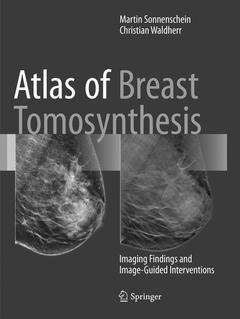Description
Atlas of Breast Tomosynthesis, Softcover reprint of the original 1st ed. 2017
Imaging Findings and Image-Guided Interventions
Authors: Sonnenschein Martin, Waldherr Christian
Language: English
Subject for Atlas of Breast Tomosynthesis:
231.04 €
In Print (Delivery period: 15 days).
Add to cartPublication date: 07-2018
Support: Print on demand
295.39 €
In Print (Delivery period: 15 days).
Add to cartPublication date: 06-2017
556 p. · 21x27.9 cm · Paperback
Description
/li>Contents
/li>Biography
/li>Comment
/li>
Martin Sonnenschein is a board-certified radiologist who is currently Head of the Department of Radiology and Nuclear Medicine at Engeried Hospital, Bern, Switzerland, which is a EUSOMA-certified Breast Center of the Lindenhof group. Dr. Sonnenschein completed his medical degree at Friedrich-Wilhelms-Universität (University of Bonn) in 1994. After undertaking residencies in Internal Medicine and Diagnostic Radiology, he became senior resident in the Departments of Diagnostic Radiology at Inselspital Bern and Sonnenhof AG, Bern and an Associate Partner in the Brunnhof Radiology Group. His special interest is the radiological aspects of senology, with a particular focus on breast tomosynthesis. He is a leading pioneer in the field: he integrated breast tomosynthesis into his daily practice and diagnostic workup as long ago as 2008 and organized the first workshop on the subject in the German-speaking countries in 2010. The first installation of the C-View software worldwide wasat Engeried Hospital in 2012. Dr. Sonnenschein was also one of the first users of tomosynthesis-guided vaccum-assisted biopsy (T-VAB). He is the author of more than 30 scientific publications in peer-reviewed journals.
Christian Waldherr serves as Co-Chair of the Department of Radiology and Nuclear Medicine at Engeried Hospital, Bern, Switzerland. He is board certified in Radiology and Nuclear Medicine. Dr. Waldherr received his MD from Kiel Medical University, Germany, in 1998 and subsequently completed a nuclear medicine residency at University Hospital Basel, Switzerland. He then undertook a research fellowship at the University of Los Angeles, USA, focusing on radiopeptide imaging and tracer development. Due to the emergence of hybrid imaging, he returned to Switzerland and joined the radiology residency program at the University Hospital Bern in 2003, becoming a faculty member in the Department of Radiology in 2007. In 2009, Dr. Waldherr joine
These books may interest you

Current MR Imaging of Breast Cancer, An Issue of Magnetic Resonance Imaging Clinics of North America 111.48 €

Breast Imaging 241.19 €


